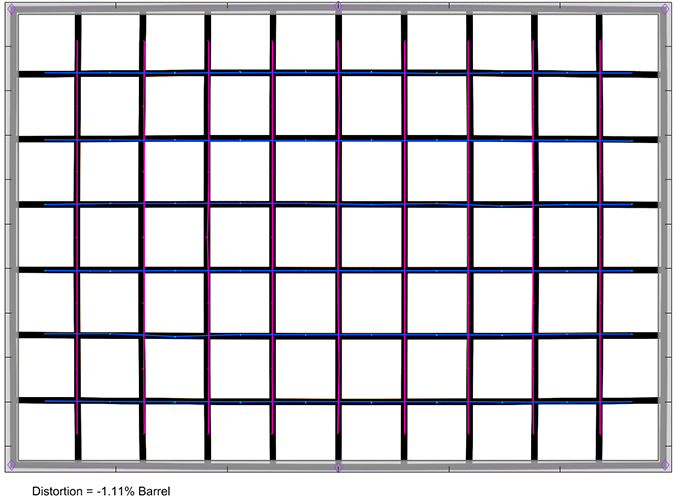|
Pergear 25mm f/1.8 (E-mount) - Review / Test Report - Analysis |
|
Lens Reviews -
Sony Alpha/NEX (APS-C)
|
|
Page 2 of 3

Distortion
The Pergear 25mm f/1.8 produces a mild amount of barrel distortions (~1.1%) on our lab chart which is usually not an issue in real life.

Vignetting
The amount of vignetting is rather extreme with a peak of 2.75 EV (f-stops) at f/1.8. The very small diameter of the front element is taking its toll here. While such an amount of vignetting would be normal with fast full format lenses, it's too much in the APS-C scope really and it's also way beyond our usual scale for the chart below. Stopping down to f/2.8 helps but it's only acceptable at f/4 and good from f/5.6 onward.

MTF (resolution)
In terms of resolution, you can't expect wonders from such a lens but keeping the price in mind, it's not too bad actually. The center quality is very good at f/1.8 and the borders are at least on a good level. The extreme corners are soft though. This doesn't really change much at f/2.2 but things are improving from f/2.8. The center reaches excellent results and the outer field improves quite a bit in quality. The peak performance is reached between f/4 and f/5.6 with very sharp images across the image field. Diffraction effects set in at f/8 but are only affecting the image center to a minor degree and the borders/corners remain on a very high level. The drop in quality is, of course, more pronounced at f/11 and beyond.
The lens has a medium degree of field curvature. The centering quality of the tested sample was good.
Please note that the MTF results are not directly comparable across the different systems!
Below is a simplified summary of the formal findings. The chart shows line widths per picture height (LW/PH) which can be taken as a measure for sharpness.
If you want to know more about the MTF50 figures you may check out the corresponding Imatest Explanations

Chromatic Aberrations (CAs)
Lateral CAs are very well controlled with an average CA pixel width around the 0.4px mark at the image borders. Given the very simple construction of the lens, this is almost surprising.

Bokeh
The Pergear 25mm f/1.8 is obviously a fast lens. Regarding its focal length and APS-C nature, it's not going to be a bokeh wonder in every situation but if your main subject is relatively close, you can achieve a decently shallow depth-of-field. So what about the quality of the out-of-focus rendering?
As you can see below out-of-focus highlights are perfectly circular at f/1.8. The inner substructure is generally clean but you may spot some imperfections there - possibly from minor scratches on a lens surface. If you stop down, the circular shape is pretty much gone immediately despite the use of no less than 10 aperture blades. Thus the blades are not curved for maintaining the circular shape a little longer. The more you stop down, the more obvious is the shape of the edgy aperture.
 As usual, the highlight discs deteriorate towards the image corners. This is a mechanical vignetting effect from the lens barrel resulting in a "cat-eye" shape. The more you stop down, the more this is corrected but the circular shape isn't really restored by f/4.
We didn't run all our bokeh tests this time. However, the image below may illustrate that the general blur is fairly decent albeit not perfect.
As usual, the highlight discs deteriorate towards the image corners. This is a mechanical vignetting effect from the lens barrel resulting in a "cat-eye" shape. The more you stop down, the more this is corrected but the circular shape isn't really restored by f/4.
We didn't run all our bokeh tests this time. However, the image below may illustrate that the general blur is fairly decent albeit not perfect.

Flare
One of the biggest challenges in lens design is minimizing flare. Coating the lens elements is one aspect but it's also about minimizing internal reflections using light-absorbing materials. This is a fairly expensive procedure thus if you want to offer a lens at a low price this is one of the places where you have to cut corners and this shows up here. The Pergear 25mm f/1.8 has merely 5 elements but if pushed, you can create quite an amount of glare and ghosting effects. To be fair though - we have had many higher-priced lenses in the lab that weren't much better.

|